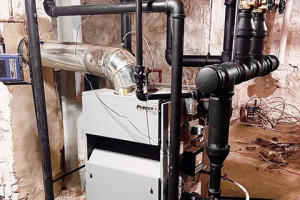
Hello, old friend. I’m writing today to say thanks, and to say farewell. This will be my last column.

So I’ve known this guy (let’s call him Jerry) for a very long time. We came up in the business together, and I like him. He’s a good guy, and if he lived next door he would have no problem loaning me a shovel, or even his lawnmower if he wasn’t using it that day.
Jerry does have this one advantage over everyone else in the world, though. In all the years I’ve known him, he has never once said that he was wrong about anything. He’s been involved in jobs that have gone wrong, of course. I mean, who hasn’t? But in every case when things went awry on any of Jerry’s jobs it was someone else’s fault. I have long marveled at the consistency of that. Jerry is never wrong, but he is surrounded by people who often are. Always.
Oh, and he knows everything about heating. He really does. He’ll call me now and then to ask me to look at a job with him, and I’m always happy to go because he gets involved in some interesting buildings. Many of these buildings are old and heated with steam; and I love old buildings, especially those with steam challenges.
Last summer, he called to say he was putting a big steam boiler into a five-story apartment building that dated back to the late-‘40s. “I have some concerns about the return piping,” he said. “Can you take a look and see if you agree with what I’m seeing?"
I was happy to help.
The old, cast-iron boiler was gone and the new one was on its way. It would be a horizontal, fire-tube boiler, which is common for a building this size in New York these days.
When we got there, we first walked the building with the superintendent because I wanted to see the piping and what sort of heat units we had. All the apartments had one-pipe-steam convectors. This was nothing unusual for that era. The ends of the steam mains had main vents, but they looked like they were in bad shape so Jerry and I talked about that. He said he knew about the main vents already. As I said, he knows everything.
We traced the return mains. They ran around the perimeter of the basement and back to the boiler.
“It’s a gravity-return system,” I said to Jerry. “Simple.”
“Well, the new boiler is getting a boiler-feed pump,” Jerry said.
“Why?” I asked. “It doesn’t need a boiler-feed pump. It would be crazy to add one to a system that is so simple. Why add all that extra cost and the maintenance needed as the years go by?”
Jerry smirked. He does that a lot.
“Seriously,” I said. “Why are you doing this?”
“Why?’ he said. “Why? Because I want to. That’s why.”
“But the job doesn’t call for it,” I said.
“It does now,” Jerry said. “It’s in the price. The job is sold. It’s getting a boiler-feed pump.”
“Okay,” I said.
“What?” Jerry said. “Why are you looking at me like that?”
“Because you’re selling them something they don’t need,” I said.
“I am not!” he said.
“Okay,” I said.
“I’m just concerned about the return piping,” he said. “I don’t want to get steam into the receiver of the boiler-feed pump.”
“You should be concerned,” I said. “And you don’t need the pump or its receiver. This system has run on gravity since before you and I were born. There’s no need for a boiler-return pump on this job.”
“It’s bought and paid for, Dan,” Jerry said. “And it’s going in.”
“Okay,” I said.
“I’m going to put a big float-and-thermostatic trap right here,” Jerry said, tapping the end of the return with the tip of his work boot. “I’ll turn this pipe up and put the trap right at the inlet to the receiver."
“That’s going to give you a lot of water hammer,” I said. “You’ll be turning the wet return into a steam line that fills with water because of the U-tube you’ll create when you turn that pipe up. And the condensate will be hotter than what your boiler-feed pump can handle.”
“So what do you suggest?” Jerry said, smirking again.
“You could build a false waterline on the return by bringing the wet return up into a vertical tank that has two steam traps piped into its side. Equalize the top of the tank with steam from the boiler and the building will go back to being gravity-return. The returning condensate will fill the tank and spill through the two traps and into the boiler-feed pump’s receiver. The condensate will be cool enough for the pump to handle without cavitation problems. The pump will last much longer that way.”
“You think I need two steam traps for this,” Jerry said, stating, not asking. He knows everything.
“Yes,” I said. “For varying condensate loads. It’s not that cold every day. The two traps will be at different levels in the tank, one lower than the other. On mild days, the lower trap will handle all the condensate. On colder days, when the lower trap can’t keep up, the condensate level in the tank will rise and the upper trap will discharge the rest of the load. Doing it this way neither trap will be oversized and they’ll last much longer.”
“I knew all of that,” Jerry said, smirking.
“Okay,” I said. “Then why did you ask me?”
“I wanted to see if you knew what I already know, okay?”
“Okay,” I said.
But then he looked concerned.
“What’s wrong?” I asked.
“What you’re suggesting is going to add cost to the job. I mean if I do what you say.”
“Yes,” I said.
“But the job’s already sold.”
“As you said.”
“I think my way’s the better way to go,” he said. “I’m just going to use the big trap at the end of the return main.”
“That will be a mistake,” I said.
“I don’t make mistakes,” Jerry said.
“Yes, I know.”
“Why don’t you just install the boiler with a gravity-return?” I said. “It’s worked that way for more than 70 years. That should tell you something.”
“I like boiler-feed pumps,” Jerry said.
“And you already sold it,” I said.
“Yes.”
“So use the false waterline piping,” I said.
“You don’t know everything, you know,” Jerry said. “I’m older than you.”
“Yes, that’s true,” I said. “By two years.”
“And I’ve been doing this for a long time.”
“Yes,” I said.
“I don’t have to listen to you,” Jerry said.
“I know.”
“But if I do listen to you, and if it doesn’t work, it’s not going to be my fault. It’s going to be your fault,” he said.
“I’m good with that. I don’t have any skin in this game. You just asked me to take a look. I looked. I’m telling you how it should be. You’re telling me how you want it to be, which is more complicated. You’ve already sold more-complicated so here we are. But you do need the false waterline to make it work.”
“It had better work,” Jerry said.
“It will.”
And it did. And the customer never knew that he had bought a lot more than he needed to buy to make the job work, but that didn’t matter to Jerry. He got the job done his way. Well, sort of his way.
I still like him, though. He’s consistent. He’s never ever wrong. You don’t meet many guys like that.
But then again, maybe you do.

Hello, old friend. I’m writing today to say thanks, and to say farewell. This will be my last column.

My six-year-old grandboy, Brendan, was in the vestibule of the diner when the bubblegum machine caught his attention. It was one of those spiral models that appeared in t...

Subdural posed a question on The Wall at HeatingHelp.com in the Strictly Steam section, where some of the sharpest knives in the drawer post every day. The question was a...